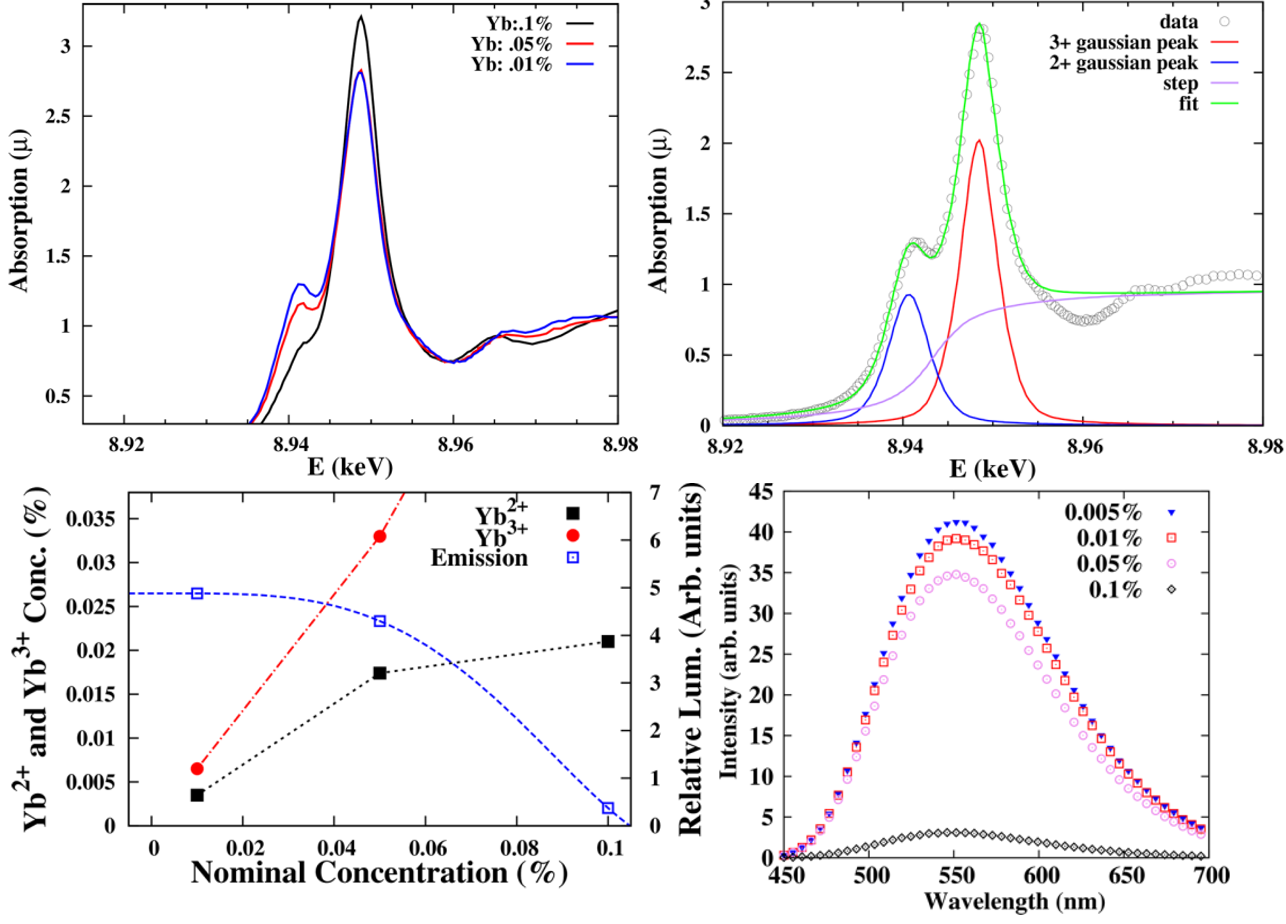- 1962年就有CaF2:Yb2+奇异发光的报道;
- 1980s McClure and others用impurity trapped exciton (ITE)的理论去解释;
- 2003年Dorenbos整理了可能涉及ITE奇异发光的list,主要是Yb和Eu掺杂;
- 2014年 Barandiaran and Seijo用理论得到结论that none of the electronic states of the Yb2+ active centers can be considered responsible for the anomalous emission;
CaF2:Yb2+的ITE发光过程描述:Upon UV excitation (within this model), one of the 4f14 electrons of Yb2+ is excited to the 4f135d state; this state decays to the exciton state in which the excited electron forms a delocalized extended state on neighboring metal atoms. The resulting Yb3+ ion plus the delocalized electron state forms the transient ITE state−a bound electron−hole pair. While in the ITE state, the cube of surrounding F− atoms should collapse slightly (again a transient effect), leading to a decreased Yb−F bond distance, by ∼0.2 Å,4 which explains the bandwidth of the emission.
在ITE模型中,UV激发产生的excitons的数量应该和Yb2+的数量成正比,当提出这个模型的时候,人们并没有方法去测量Yb2+的浓度,以验证这种线性关系(Yb2+浓度和奇异发光的强度)。直到最近,才可以测量very low defect concentrations down to 0.01% Yb。作者的现象/结论:
(1) 奇异发光的强度不和Yb2+的浓度成正比;
(2) 只有a small fraction of Yb2+ ions参与了发光。

- 第一张图,前面的峰对应于Yb2+,后面的峰对应于Yb3+。掺杂浓度低的时候,两个峰可以很好地区分开。对于掺杂浓度为0.01%的样品,反而其Yb2+的峰最强。
- 第二张图,对应于0.01%掺杂浓度的样品,可以用两个pseudo Voigt peaks plus a step function来拟合出来,然后借助特定的参数,就可以知道样品中Yb2+和Yb3+的比例。
- 第三张图,给出了不同Yb掺杂浓度下,Yb2+和Yb3+各自的浓度,以及该样品的PL强度。Yb2+的浓度tends to saturate even near 0.05% Yb。
- 第三张图数据分析,图中用的是名义浓度nominal concentration,而不是实际浓度actual concentration,二者之间存在一个比例系数S(segregation coefficient),S的偏移不超过10-20%,因此不影响最终结果的分析。
- 第四张图,是不同掺杂浓度下的PL图,in contrast to the variation of the Yb2+ concentration, the anomalous emission intensity decreases as the nominal concentration increases.
结果分析:上述实验结果inconsistent with the accepted ITE model for anomalous luminescence from Yb centers in CaF2。Yb2+浓度很小的时候,奇异发光反而最强。可能的new model就是Barandiaran and Seijo给的解释,奇异发光来自Yb2+和Yb3+之间的IVCT。
(1) The same interpretation has been used to understand that X-ray excitation triggers the anomalous emission of Yb in CaF2 but not in SrF2.
(2) 只有 a fraction of the initially excited Yb2+ would ultimately lead to IVCT luminescence because the nonradiative transitions (step II of model) branch along several pathways, several of which go either directly to the ground state or indirectly via Yb3+ emissions. 这些pathways都不会导致550 nm的发光。
(3) 电荷补偿和格位:it has been suggested from experiments that it is only the nonlocally compensated (cubic) trivalent ions which participate in the charge transfer from divalent to trivalent lanthanide ions (e.g., from Eu2+ to Sm3+ in CaF2). 因此these cubic nonlocally compensated Yb3+ ions are more probable as the concentration is lowered and hence the IVCT between cubic Yb2+ and Yb3+ centers appears to be in qualitative agreement with the large observed increase in anomalous emission for low Yb concentrations.
(4) It may be that many of these systems, currently assumed to be described by the ITE model, do not have a linear relationship between emission intensity and Yb2+ concentration; such cases may be better described by the IVCT model.